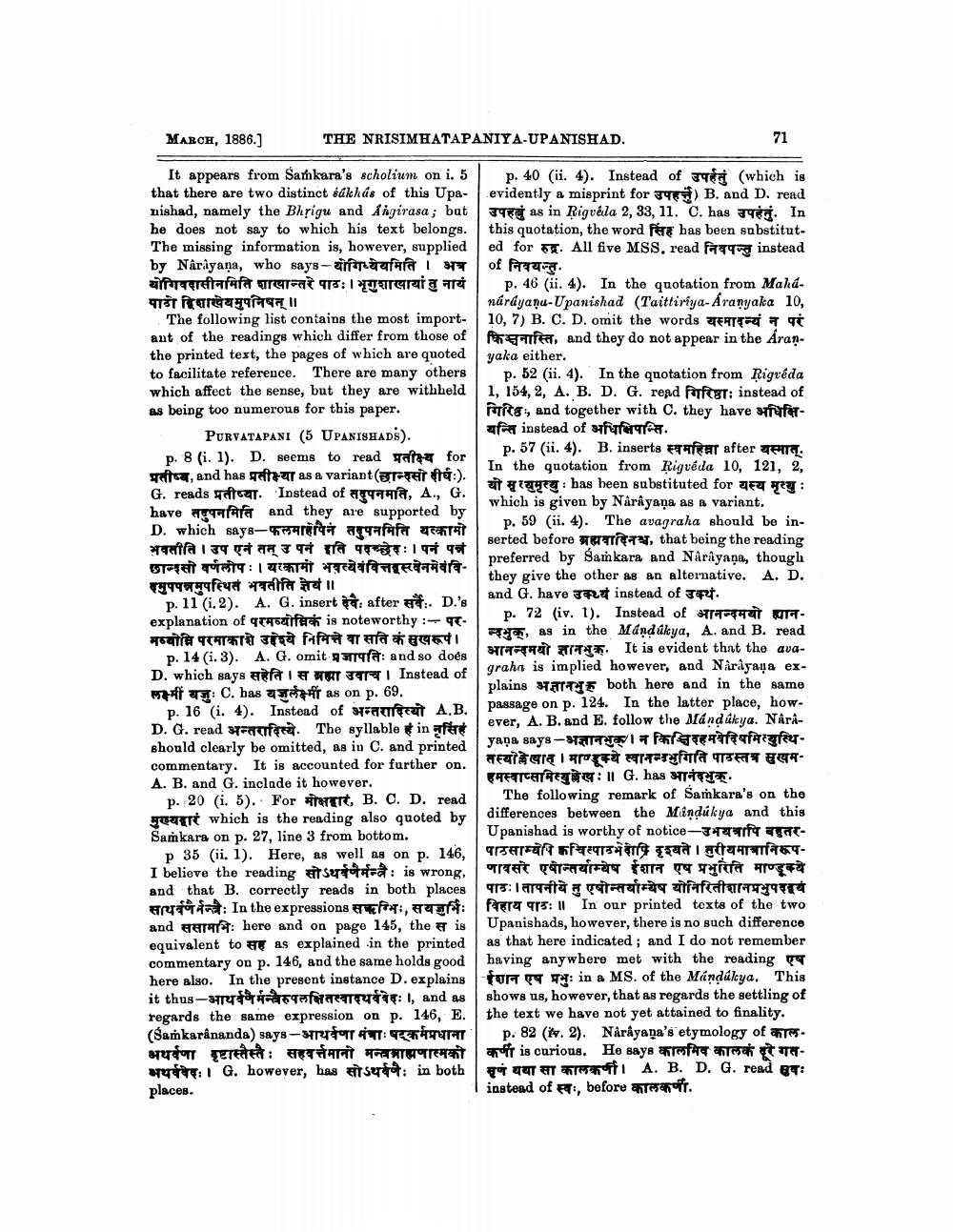________________
MARCH, 1886.)
THE NRISIMHATAPANIYA-UPANISHAD.
71
It appears from Sankara's scholium on i.
5 p . 40 (ii. 4). Instead of ye (which is that there are two distinct súkhús of this Upa- evidently a misprint for 345) B. and D. read nishad, namely the Bhrigu and Angirasa; but 396 as in Rigvéla 2, 33, 11. C. has 396. In he does not say to which his text belongs. this quotation, the word for has been substitutThe missing information is, however, supplied ed for . All five MSS, read instead by Narayana, who says-योगिध्येयमिति । अत्र of for योगिवदासीनमिति शाखान्तरे पाठः । भृगुशाखायां तु नायं p. 46 (ii. 4). In the quotation from Maháपाठी विशाखेयमुपनिषत् ।।
nárdyaņu-Upanishad (Taittiriya-Aranyaka 10, The following list contains the most import- 10, 7) B. C. D. omit the words TEATTE T ant of the readings which differ from those of feat, and they do not appear in the Aranthe printed text, the pages of which are quoted
yaka either. to facilitate reference. There are many others p. 52 (ii. 4). In the quotation from Rigveda which affect the sense, but they are withheld 1, 154, 2, A. B. D. G. read fufcet: instead of as being too numerous for this paper.
TTC, and together with C. they have affar PURVATAPANI (5 UPANISHADS).
af instead of afferta.
__p.57 (ii. 4). p. 8 (i. 1). D. seems to read tate for
B. inserts स्वमहिना after यस्मात्,
In the quotation from Rigveda 10, 121, 2, प्रतीष्ब, and has प्रतीभ्या as a variant(छान्दसो दीर्घः). G. reads प्रतीष्या. Instead of सदुपनमति, A., G.
o Timmy: has been substituted for get TT:
which is given by Narayana as a variant. have hafa and they are supported by
p. 59 (ii. 4). The avagraha should be inD. which says-फलमाहोपैनं तदुपनमिति यत्कामो
serted before TN, that being the reading भवतीति । उप एनं तन् उ पनं इति पदच्छेदः । पन पत्र छान्दसो वर्णलोपः । यरकामो भवत्येववित्तवसवेनमेवंवि
preferred by Samkara and Narayana, though
they give the other as an alternative. A. D. समुपपन्नमुपस्थित भवतीति ज्ञेयं ।। p. 11 (i. 2). A. G. insert : after a D.'s
and G. have उक्थ्यं instead of उक्थ. explanation of परमव्योनिकं is noteworthy:-पर
p. 72 (iv. 1). Instead of TT - मब्बोनि परमाकाशे उद्देश्ये निमित्ते वा सति कंसखरूप।
, as in the Mand ákya, A. and B. read p. 14 (i. 3). A. G. omitt a: and so does
STT TA It is evident that the ava
graho is implied however, and Nariyana exD. which says सहेति । स ब्रह्मा उवाच | Instead of लक्ष्मी बजुः C. has यजुर्लक्ष्मी as on p. 69.
plains STATE both here and in the same p. 16 (i. 4). Instead of wratiecent A.B.
passage on p. 124. In the latter place, howD. G. read water. The syllable in afar
ever, A. B. and E. follow the Mandúkya. Nárashould clearly be omitted, as in C. and printed
yana says-YETTI a Parigraffecommentary. It is accounted for further on.
तस्यालेखात । माक्ये स्वानन्मभुगिति पाठस्तत्र सुखमA. B. and G. inclade it however.
GHETETTE: 1 G. has r . p. 20 (i. 5). For H TT, B. C. D. read The following remark of Sarkara's on the go which is the reading also quoted by
differences between the Mandúkya and this Samkara on p. 27, line 3 from bottom.
Upanishad is worthy of notice-उभयत्रापि बहुतरp 35 (ii. 1). Here, as well as on p. 146, पाठसाम्यपि कचिस्पाठभेदोषि दृश्यते । तुरीयमात्रानिरूपI believe the reading as a : is wrong, णावसरे एषान्तर्याम्येष ईशान एष प्रभुरिति माण्डूक्ये and that B. correctly reads in both places
पाठः । तापनीये तु एषोन्तर्याम्येष योनिरितीशानमभुपदवयं ne: In the expressions eft, aft: Et 95: | In our printed texts of the two and Fa : here and on page 145, the isUpanishads, however, there is no such difference equivalent to as explained in the printed as that here indicated ; and I do not remember commentary on p. 146, and the same holds good having anywhere met with the reading here also. In the present instance D. explains for T : in a MS. of the Mandákya. This it thus-Br o
TTY : 1, and as shows us, however, that as regards the settling of regards the same expression on p. 146, E. the text we have not yet attained to finality. (Samkarananda) says- TV: TUTTI p. 82 (t. 2). Narayana's etymology of ato. su retea: Art Mut aff is curious. He says after
a tt 74 :I G. however, has at : in both GUT ET
A. B. D. G. read er: places.
| instead of स्वः, before कालकी .
4 bottom.




